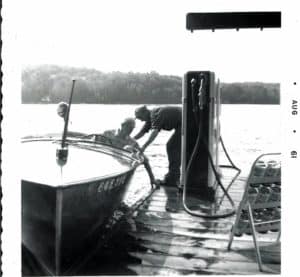A Tale of Two Guitars – With Apologies to Dickens
A tale of two guitars, as with any other tale, must have a beginning. And indeed, these two guitars must have the same beginning, and it is claimed to be in the 1930s.
We are talking about two, as they are advertising, 1930’s Vintage May Bell by Slingerland Archtop Acoustic Guitars. One is just lovely. They other is, well, somewhat less than lovely.
But here is where the tale of two guitars begins to get really interesting: One is listed on an auction site with a bid of $76 on it. The other is expected to fetch no less than $999!
Why is there such a difference? Should there be such a difference?
Here’s a hint. The one is in, shall we say, in need of some very serious luthiery care, while the other is in beautiful, almost flawless condition. But the question is, which one is the most valuable?

Here’s where the tale of two guitars starts to get interesting. I remember this from the days when I had the great pleasure of rebuilding and refinishing antique wooden boats at my grandfather’s shop in Port Carling, Ontario.
There was some debate at that time over what could be considered to be a restored antique launch, and what was simply a beautiful replica. Of course, the replica could not be as valuable at a real, restored antique. But since they don’t make the originals, any more (or they wouldn’t be antiques), it got very difficult to find a boat to restore. Have you seen any worth restoring? Maybe let us know in the comments. You might just make someones day.
Some of the boats I saw being bought up for restoration were, as the old saying goes, fit for no more than “keep the propeller shaft and build a new boat around it.” And some of the old, cold-rolled steel propeller shafts were getting pretty long in the tooth, as well.
Boat refinishing is a competitive business. It’s difficult to make much money on it. But rebuilding antique boats – well – that was a very different story. Few, other than the remaining shops that once produced the boats were equipped to rebuild the old boats.
Thus, those shops really wanted the business, even if the boat they were tasked to rebuild was nothing but garden fill. So the trick became to find one piece of solid wood, usually in the stem of the boat (that’s the final vertical piece in the pointy end), cut it out, and then glue it into the new stem.
Then they could call it a rebuilt boat, since not all the wood was replaced…
There are scratch marks on the top. The bridge has a small crack in one end. The tail piece is in great need of either a really good clean, or perhaps it needs to be re-chromed.
The neck is pulling away from the body and needs to be reglued, but it actually looks like it still has the original protein glue, rather than modern carpenter’s glue, meaning that it can be cleaned out and reglued without having to chisel it off and risk damaging the wood.
The seller says some of the frames inside are loose and combined with the problems with the neck, it’s not presently playable. But I can tell you from experience in fixing these things that it can be repaired quite handily.
There’s also a crack in the center on the back of the guitar your could fix quite nicely with a mixture of protein glue and sawdust. All in all, the guitar looks like a steal of a deal at its present bid. If I didn’t have boxes of guitars waiting for me to repair, I would definitely bid on it!
Now we come to the other guitar, the one with a fixed price of $999. It looks pretty nice, does it not? The problem is with how original it really is. It’s being sold as a 1930’s Vintage May Bell by Slingerland Archtop Acoustic Guitars, just like the other one. In this case, however, I would be wanting to do some really careful research and still probably wouldn’t buy it.
It really is pretty, and if all original, in amazing condition for such an old guitar. Are those strings actually touching the last three frets just before the nut? It the neck starting to part from the body? Are the maple sides and back original?
This is probably a really nice guitar. It’s being sold by a very reputable seller on Ebay. But before buying anything vintage, especially when you start forking over a grand for something that’s not worth more than a hundred bucks if it’s not all original, it’s important to ask some questions.
It’s also important to own a good price guide like the one shown
A good collector’s guide tells you what to look for, what variations there are, and what things are worth, depending on their condition. Many times an item is worth more unrestored than in gorgeous, restored condition.
If you’re interested in collecting vintage guitars, you will find it rewarding in many ways. There’s nothing quite like finding a real prize in a flea market, garage sale or thrift store, cleaning it up a bit, adding some new strings and finding out that it still sounds awesome!
Some people believe that old guitars aren’t worth anything other than as wall hangers, but the truth is, as any good violin player knows, the quality of sound often improves over the years as the wood ages.
So as the tale of two guitars draws to a close, what do you think? If money was not an issue, which guitar would you buy? Let us know in the comments!